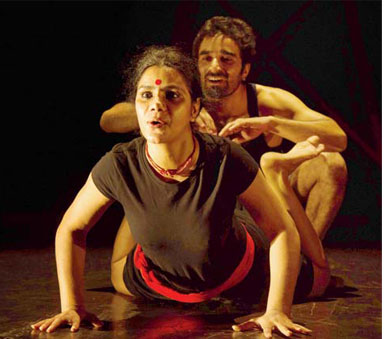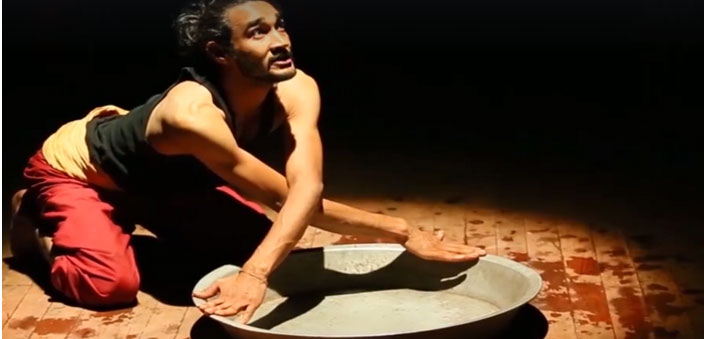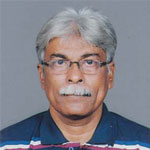All over the world, serious artists always interpret and reinterpret traditions and epics of their society. In India, this process began during the colonial era, and continued after India gained freedom. Here, one must mention Girish Karnad (born: 1938), who has been doing this for decades. With this purpose he has written plays like Nagmandal, Taledand and The Fire and the Rain, his sixth play. Each of these plays force us to look at our traditions afresh, as these plays are infused with new, modern insights. Karnad received the ‘Jnanapith’ award and was decorated with ‘Padmabhushan’ too.
Jyoti Dogra, a Mumbai-based theatre practioner, found a new expression for The Fire and the Rain in her latest production Toye, a Sanskrit word for water. In this production, the whole focus is on the human body as a primary medium of expression, which is often neglected in modern theatre productions. But then these are not conventional dance movements. In this production, actors under Jyoti’s able direction react to basic impulses like hunger, lust etc. The entire experiment and its effect are quite unique.
In 2002 came Agnivarsha, a Hindi film based on Karnad’s The Fire and the Rain. The film did not do well at the box-office. Now Jyoti Dogra has taken the challenge to reintroduce the play with a different theatrical language.
The story
Not only Jyoti’s production, even the story of the play is quite complicated. Arvasu, a Brahmin by caste, has become a performing actor. He loves Nittalai, a tribal girl who reciprocates his feelings, but insists that he must get the blessings of her father and elders of her clan. Arvasu’s elder brother Parvasu has been busy for seven years conducting a major yagna to appease the god of rains, Lord Indra. The region is reeling under severe drought for the last ten years. Their father Raibhya hates both of them and would like to see them die before his own end. The story is derived from the myth of Yavakri, which is a part of the great Indian epic, the ‘Mahabharata’.

Raibhya suspects Vishakha, his daughter-in-law and Parvasu’s wife, of having an extramarital affair with Yarviki who has returned after ten years of penance. Back then they were in love with each other. Now he finds Vishakha married to Parvasu, his arch-rival. Parvasu and Vishakha were married for three years after which Parvasu left to perform a major yagna. Raibhya is terribly angry with Vishakha and summons the Brahma Rakshas to kill Yarviki. The Brahma Rakshas does what he is ordered to do and Arvasu has to cremate Yarviki. This is why Arvasu gets late for his appointment with Nittilai’s father and elders from her clan. They marry Nittilai to someone else. When Parvasu hears of the death of Yarviki, he kills his father and ensures that Arvasu gets blamed for this. Arvasu gets beaten for this and left for dead. When Nittilai hears of this, she comes to help Arvasu but is hunted by her husband and his brother. She is killed by them. Parvasu admits his crime and cremates himself. In other words, many characters get killed one by one. This does ensure the appeasement of Indra. The purity of Arvasu and Nittilai’s love brings salvation to the land.
To stage a play like this, is always a challenge. Jyoti Dogra got in league with the team of young theatre persons who realised that the space and resources constraints would always haunt them in any urban centre. They decided to relocate to Indri, a village in Haryana, and home to one of the actors. Here they had ample space and could practice with meagre resources. They got the banner of Shaheed Somnath Smarak Samiti and now shows are being performed under this banner. This is a unique experiment in many ways.
Dogra has touched on the power play between the Brahminical characters and the love affair between a Brahmin boy and a tribal girl. She has used multiple actors to play one character. This makes the production representative of our society. Right from the beginning, the play grows organically. This is an ensemble production where each actor brings in a complexity that is his own. In this production there are different actors playing the same characters at different times. This is to compel audiences to not engage with a character as much as with the ideas and possibilities those characters represent. These ideas as well as the actors keep changing. At times, audiences find it hard to follow the story line, but that is a minor issue. What matters is the philosophical narrative that gets evolved in the play.
It is more than clear that Jyoti Dogra is inspired by Jerzy Grotovsky and keen to imbibe his ideas about theatre. Grotovsky emphasises on the use of minimal or no properties. Dogra has used a ladder, a huge swing, an earthen pot and a long broom, etc. Like these properties, costumes and makeup was minimalist too. With such an approach, Dogra has created a magical production based on Karnad’s play.


 [/column]
[/column]